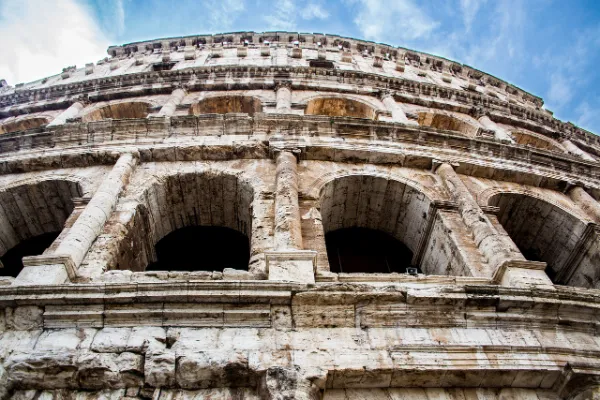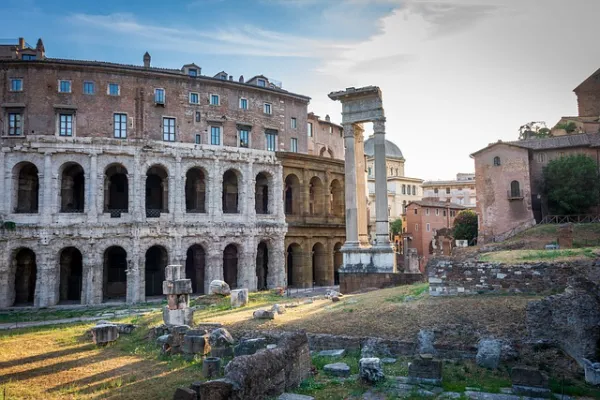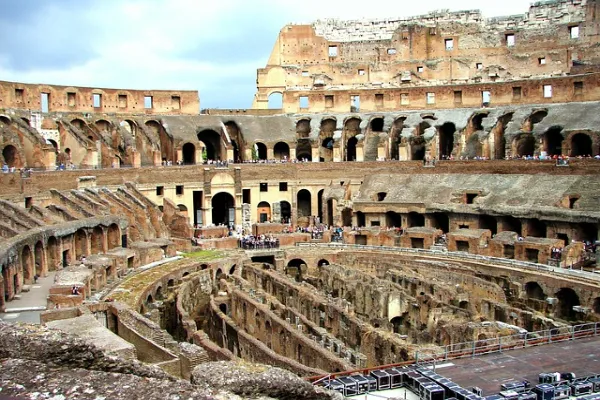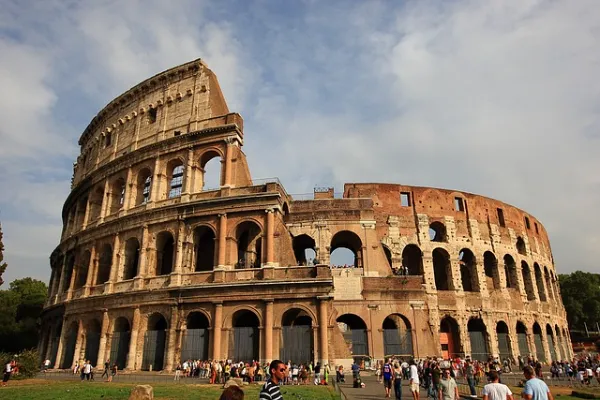Interesting Facts About the Colosseum

Towering over the heart of Rome, the Colosseum, also known as the Flavian Amphitheatre, stands as a testament to the ingenuity and grandeur of the ancient world. This iconic structure is more than just a well-preserved monument; it’s a portal to a bygone era, brimming with captivating stories and intriguing facts. From its size and architecture to its tales of gladiatorial battles and elaborate spectacles, the Colosseum continues to enthrall. We will present some interesting facts about the Colosseum, revealing why it remains a must-see attraction.
What are some interesting facts about the Colosseum?
- Engineering marvel: The Colosseum is the largest amphitheater ever built and could seat around 80,000 spectators. Amazingly, it only took eight years to construct (70-80 AD) using over 100,000 cubic meters of stone and concrete. The Romans even used an ingenious system of ramps and elevators to quickly move animals and gladiators around the complex.
- A roof, but not as you know it: The Colosseum had a retractable roof, made of waterproof fabric called the “velarium.” This roof could be unfurled to shield spectators from the sun or rain.
- More than just gladiatorial combats: While gladiatorial contests were a major attraction, the Colosseum also hosted a variety of other events. This includes animal hunts, mock sea battles, public executions, and even theatrical performances.
- Hidden chambers: Beneath the arena floor was a complex network of tunnels, chambers, and cages. These were used to house gladiators, animals, and stage machinery.
- A changing stage: The arena floor was made of wood and covered in sand. Trap doors on the floor could be opened to reveal surprises during performances. This included wild animals or scenery emerging from below.
Uncovering the Secrets of the Colosseum: 7 Fascinating Facts
The Colosseum, also known as the Flavian Amphitheater, stands as a majestic reminder of the power and ingenuity of the Roman Empire. This iconic landmark continues to captivate visitors with its grandeur and rich history. But beyond its awe-inspiring facade lie fascinating secrets waiting to be discovered. Prepare to be surprised as we delve into seven intriguing facts that unveil the true essence of the Colosseum.
- Construction: The construction of the Colosseum began in AD 70 under the Emperor Vespasian and was completed in AD 80 under his son, Titus. It was built using concrete and limestone, with a seating capacity of approximately 50,000 spectators.
- Design: The Colosseum is an elliptical amphitheater, measuring 189 meters long, 156 meters wide, and 48 meters high. It features a series of tiered seating arrangements, with different sections allocated for various social classes.
- Events: The Colosseum was primarily used for hosting gladiatorial contests, animal hunts, and mock sea battles. These events were held to entertain the Roman populace and demonstrate the power and grandeur of the Empire.
- Engineering: The Colosseum was a marvel of Roman engineering, with a sophisticated system of pulleys, elevators, and trapdoors used to stage elaborate performances. The arena could be flooded for naval battles and covered with sand to absorb blood during gladiatorial fights.
- Destruction: Over the centuries, the Colosseum suffered damage from earthquakes, fires, and looting. Much of its original marble façade was pillaged for use in other buildings, leaving the structure in a state of disrepair.
The Colosseum: A Marvel of Ancient Engineering and Design
In the heart of Rome lies the Colosseum, a testament to the ingenuity and skill of ancient Roman engineers and architects. Officially named the Flavian Amphitheatre, this iconic structure was constructed between 70 and 80 AD during the reign of the Flavian emperors.

Standing tall as an elliptical object, the Colosseum boasts impressive dimensions: 189 meters in length, 156 meters in width, and reaching a height of 48 meters. This colossal size allowed it to seat a staggering 50,000 to 80,000 spectators, solidifying its place as one of the largest amphitheaters ever built.
Beyond its sheer size, the Colosseum is a masterpiece of engineering. A complex system of vaults, arches, and columns work together to support the massive structure. The outer walls are clad in travertine stone, while the interior relies on a combination of brick and concrete for its strength. The arena floor itself, once the stage for gladiatorial combats, was crafted from wood and covered in sand to absorb blood during these brutal spectacles.
The Colosseum stands as a remarkable testament to the advancements of Roman engineering and continues to inspire awe and fascination centuries later.
The Bloody History of the Colosseum: Gladiators, Lions, and Spectacle
The Colosseum, also known as the Flavian Amphitheatre, stands as a stark reminder of a bygone era, its grandeur interwoven with a dark and bloody history. Constructed between 70-80 AD by the Flavian emperors, Vespasian and Titus, this iconic structure quickly became the epicenter of spectacles that continue to captivate scholars and history enthusiasts alike.
Within its walls, gladiatorial combat reigned supreme. These trained warriors, often slaves or war captives, were forced to fight to the death for the entertainment of the Roman populace. Clad in various armor and armed with diverse weaponry, they engaged in brutal battles before a roaring audience. Victors were hailed as heroes, while the vanquished met gruesome fates, leaving the arena floor stained crimson.
Beyond the human combat, the Colosseum served as a stage for exotic animals like lions and other ferocious beasts. These creatures were pitted against each other or unfortunate human opponents in displays of raw power and violence. The crowds, fueled by an insatiable thirst for excitement, roared as they witnessed these savage encounters unfold.
However, the spectacles held within the Colosseum transcended mere entertainment. They served as a potent tool for the emperors, a means to assert their dominance and control over the Roman people. By offering these violent displays, the emperors aimed to distract the populace from everyday hardships.
Did You Know? 7 Surprising Facts About the Colosseum in Rome
- The Colosseum was originally known as the Flavian Amphitheater. It was named after the Flavian dynasty of emperors, who commissioned its construction in the first century AD.
- The Colosseum could hold an estimated 50,000 to 80,000 spectators, making it one of the largest amphitheaters in the Roman Empire.
- Contrary to popular belief, the Colosseum was not solely used for gladiatorial combat. It also hosted animal hunts, mock sea battles, and theatrical performances.
- The Colosseum’s iconic facade was originally adorned with statues of gods and emperors, as well as decorative elements like bronze shields and colorful marble.
- The Colosseum’s underground tunnels and chambers were used to house animals, gladiators, and machinery for special effects during events.
- The Colosseum has undergone several restorations over the centuries, including repairs after earthquakes and damage caused by looting and vandalism.
- The Colosseum is a UNESCO World Heritage Site and one of the most visited tourist attractions in Italy, attracting millions of visitors each year.
Beyond the Gladiators: Lesser-Known Facts About the Colosseum
The Colosseum, also known as the Flavian Amphitheatre, stands as a majestic landmark in Rome, Italy. While its image may conjure up visions of gladiatorial combat, this iconic structure boasts a rich history.
Contrary to popular belief, the Colosseum served a wider purpose than just gladiatorial games. The vast arena hosted a diverse array of events, including thrilling mock sea battles, where intricate sets transformed the floor into a temporary ocean. Animal hunts, showcasing exotic creatures from across the empire, further fueled the crowds’ excitement.

Additionally, theatrical performances, a cornerstone of Roman culture, graced the Colosseum stage, offering a more artistic counterpart to the arena’s other events. These diverse spectacles not only entertained the Roman populace but also served as a powerful display of the empire’s might.
Beyond its historical significance, the Colosseum’s design itself is a marvel of Roman engineering and ingenuity. As the largest amphitheatre ever built in the empire, it offered seating for up to 80,000 spectators. A complex network of underground tunnels and trapdoors facilitated the dramatic and efficient movement of gladiators, animals, and scenery. This added to the spectacle and enhanced the audience’s awe.
The Colosseum: A Symbol of Power, Entertainment, and Architecture
The Colosseum, also known as the Flavian Amphitheater, stands as a monumental symbol of power, entertainment, and architectural mastery in ancient Rome. Constructed under the emperor Vespasian in the first century AD and completed by his son Titus, this iconic structure served as a venue for public spectacles. This included gladiatorial contests, animal hunts, and mock naval battles.
The Colosseum’s imposing elliptical shape, measuring 189 meters in length and 156 meters in width, reflects the advanced engineering skills of the Roman architects and engineers who designed it. The outer facade of the amphitheater is composed of three tiers of arcades adorned with Corinthian columns and statues, showcasing the grandeur and opulence of the Roman Empire.

The interior of the Colosseum features a complex system of seating arrangements, with tiered rows of marble seats capable of accommodating up to 50,000 spectators. The arena floor, known as the “arena,” was covered with sand to absorb the blood of the gladiators and animals who fought to the death.
Despite its association with violence and brutality, the Colosseum also served as a symbol of the power and authority of the Roman emperors. The elaborate spectacles held within its walls were intended to showcase the wealth and might of the empire. They also provided a form of entertainment for the Roman populace.
From Earthquakes to Concerts: The Ever-Evolving Role of the Colosseum
The Colosseum, also known as the Flavian Amphitheater, is an iconic symbol of ancient Roman architecture and engineering. Built in the first century AD, this massive structure was originally used for gladiatorial contests, public spectacles, and other forms of entertainment. However, over the centuries, the role of the Colosseum has evolved to encompass a wide range of events.
One of the most significant changes in the Colosseum’s use occurred in 1349, when a series of devastating earthquakes caused extensive damage to the structure. In the aftermath of these natural disasters, the Colosseum was left in a state of disrepair and was largely abandoned for several centuries. It was not until the 18th century that efforts were made to restore and preserve the Colosseum, leading to its designation as a UNESCO World Heritage Site in 1980.
The Colosseum’s significance extends far beyond its gladiatorial legacy. This iconic structure has transcended its historical roots to embrace a new role in the world of cultural events. In recent years, the amphitheater has witnessed a remarkable shift, transforming from a symbol of ancient Roman spectacle into a versatile stage for contemporary entertainment.
The Colosseum thus stands as a bridge between past and present, a powerful symbol of both Roman ingenuity and the ever-evolving nature of human creativity. It remains a captivating landmark, drawing visitors not only to witness its historical grandeur, but also to experience the diverse cultural offerings that grace its stage today.